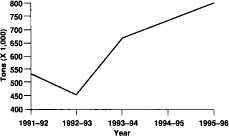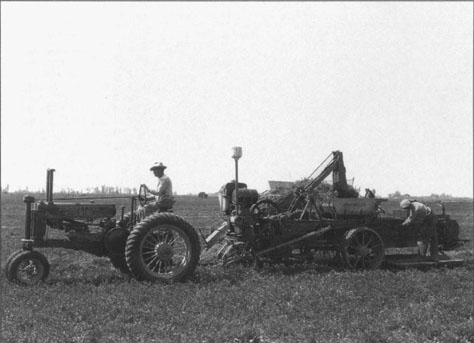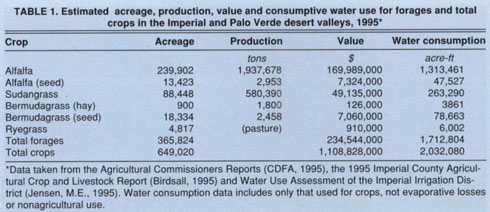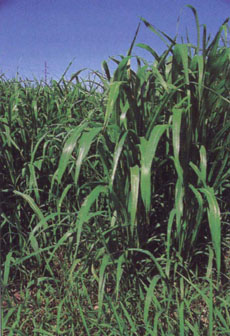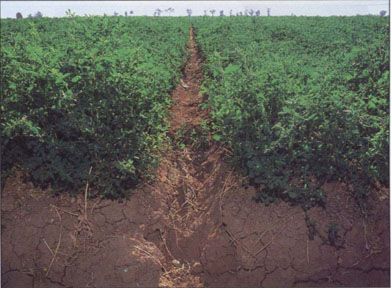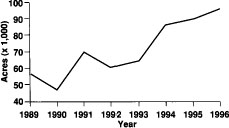All Issues
Forage demand rises as supplies wane: Growers face critical juncture in desert forage production
Publication Information
California Agriculture 51(3):12-16. https://doi.org/10.3733/ca.v051n03p12
Published May 01, 1997
PDF | Citation | Permissions
Abstract
Forages dominate the low-desert agricultural landscape. Competition for water resources is intensifying in desert regions at the same time that demand for high-quality forage crops is increasing. California is a forage-deficit state and is likely to remain so in the future. To improve and sustain forage production in the desert, research and education efforts must address limited water supplies and pest problems. Forage research should focus on the critical issues of irrigation efficiency, pest control, use of alternative forages and improvements in forage quality.
Full text
Forage crops, above, provide food for livestock and habitat for wildlife, including kestrels, right.
Forage crops, particularly alfalfa (Medicago sativa L.) and sudangrass (Sorghum bicolor spp. Sudanese) occupy a majority of crop acreage in California's southern deserts and consume more than three-fourths of the region's agricultural water. The deserts produce about 26% of California's $800 million-per-year alfalfa crop, the largest in the nation, and 95% of the state's sudangrass crop. California now produces more milk than any other state and has expanded dairy production more than 50% since 1985. The California dairy and forage industry produces nearly $4 billion in direct farm receipts and is unquestionably the largest agricultural enterprise in the state. In addition, forage exports to foreign countries — particularly from the desert Southwest — have increased substantially in recent years.
As result of these trends, demand for forages — particularly alfalfa — has outstripped supply within California. Shipments from neighboring states have increased more than 50% in the past 5 years (fig. 1). Many expect this imbalance to be essentially permanent and to continue indefinitely, due to projected continued expansion of the dairy industry in California.
In addition to supporting California's growing dairy and agricultural export industries, forages in the desert play a vital role in crop rotations by reducing nitrogen fertilizer needs, support a complex food chain that includes sheep, horses and beef cattle, provide habitat for a wide variety of wildlife and serve as insectaries for beneficial insects. Many desert ranchers would continue growing forages without substantial economic gain simply for their value in rotation with higher-value crops. As habitat for various kinds of wildlife, alfalfa fields offer cover, water from frequent irrigations, high-quality plant food and prey in the form of insects and rodents. Of the 643 wild animals and birds that occur regularly in California, 25% use alfalfa fields, including 6 species on the federal endangered or threatened species lists. Migrating waterfowl and birds of prey are particularly benefited in desert alfalfa fields.
However, several critical issues cloud the future of forage crop production in the deserts of California. Forages consume substantial quantities of water and are often targeted for water transfers from agriculture to cities or for environmental goals. Pests are currently controlled largely by genetic resistance and pesticides, but limited resources for pest control and forage breeding research may reduce our ability to address pest problems in the future. In addition, each year there is increased demand for higher forage quality from the dairy industry.
We are approaching a critical juncture in desert forage production, where demand for desert forages is increasing along with limits on water use and increased pest problems. Some of these issues can be addressed by the concerted efforts of growers, and some by research or educational efforts, while others are matters of public policy or community values. The purpose of this article is to outline the importance of forages to desert agriculture and to highlight the critical needs for research and extension programs for forages in this region.
Alfalfa — an early desert crop
Unlike most crops, which moved from east to west, alfalfa gained its first important foothold in North America in the valleys and deserts of California in the 1850s. At the turn of the century, alfalfa acreage east of the Mississippi River accounted for only 1% of the total U.S. production, and California was a major alfalfa-producing region. Alfalfa played a crucial role before the development of the high-value markets for fruit and vegetable crops now widely associated with the state's agriculture. It continues to be important today. California produces more alfalfa than any other state, though several states have higher acreage.
The advent of irrigation made alfalfa a major crop in the Imperial and Palo Verde valleys in the early 1900s.
Alfalfa was the first major crop grown in the Imperial and Palo Verde valleys after the development of irrigation in the early years of this century (1901–1905). Dairy production soon followed. Some have estimated that by 1920, there were 2,000 Imperial Valley dairies with more than 100,000 cows in production. By 1932, Imperial County was the third-largest producer of butter in the state, although dairy production later declined due to competitive advantages of other areas. In 1919, Imperial County produced 4% of California's alfalfa crop, but by 1929 it produced 12%, and today it produces about 24% of the state's total alfalfa crop. There has been a gradual shift of alfalfa acreage from coastal and Central Valley regions to the desert over the past 70 years. The shift to areas with long growing seasons has contributed to the yield increases in California, where average yields are now over 7 tons/acre, among the highest in the United States.
Current status of desert forages
Forage-related crops occupied 56% of the total acreage, produced $235 million in revenue and consumed 84% of the water used for agriculture in the low deserts of California during 1995 (table 1). Alfalfa and sudangrass occupied approximately 39% and 14%, respectively, of the total acreage in Imperial and Palo Verde valleys combined. Virtually all of the sudangrass is exported. Alfalfa primarily enters the dairy markets at Chino and increasingly the lower San Joaquin Valley. The horse industry of Southern California is also important, as is sheep grazing. Other forages, such as ryegrass pasture and forage grown for seed, occupy another 6% of the total acreage. Forages are considered a “bread-and-butter” crop in the desert, providing a steady farm income. Due to the stability of the forage market (compared with specialty crops) and distribution of income over the season, many ranches would likely fail with-out them.
TABLE 1. Estimated acreage, production, value and consumptive water use for forages and total crops in the Imperial and Palo Verde desert valleys, 1995*
The importance of desert forage production is likely to increase in the future. Alfalfa acreage in the Central Valley is projected to decline over the next two decades due to substitution by higher-value crops, urbanization and increased water costs. The California Department of Water Resources projects a statewide decrease in alfalfa and irrigated pasture of 331,000 acres by 2020, primarily in the San Joaquin and Tulare Lake hydrologic regions. This will increase the importance of and interest in forage production in the Low Desert, a geographic production area including the Coachella, Imperial and Palo Verde valleys.
The importance of water
Without a doubt, water resources will be the most critical limiting factor for desert forage production in the future. Urban demand in the South Coast region (primarily Los Angeles and San Diego), is expected to consume an additional 2.1 million acre-feet of water per year over current needs by the year 2020, for a total urban water demand of 6 million acre-feet per year. Many anticipate that the increased demand will be met at least partially by transferring water from agricultural uses.
Forages are often targeted by environmentalists and others for water transfers because they are considered low-value crops relative to the amount of water applied. This perception, however, is misleading. Alfalfa, the major forage crop in the desert, is an efficient user of water in terms of dry weight yield per unit of applied water. Although the quantities of water required each year are substantial (table 1), alfalfa grows nearly 12 months/year and yields over 8 t/acre dry matter, and little of the above-ground crop is wasted. The production of useful, dry plant material per unit of water applied is high compared with most grain or fruit crops. As a result, the water-use efficiency of alfalfa and other forages is superior to that of many other crops.
The issue of economic value is also more complex than it appears at first glance. Although there are several crops with more direct value than forages — producing greater income per unit of land area or unit of water — forages have a large and complex effect on the economy. Alfalfa is the primary raw material for dairy farming, the largest agricultural enterprise in the state. It is also the most important feed for horses and is important for sheep grazing, beekeeping and beef production. Many related industries, such as trucking, benefit from forage production. Furthermore, growing alfalfa in a crop rotation provides economically important benefits to other crops.
Nevertheless, desert growers will clearly need to learn how to produce forages with less water. This is a critical juncture for desert forage production. We must begin to address these issues in anticipation of future trends. We must mobilize our public and private scientific-research community to address these problems. Although public opinion and policy decisions are certainly important, the issues involved are to a great degree technical.
Strategies to sustain production
What strategies could sustain forage production in the desert under conditions of limited water availability? We discuss several approaches below for developing forage-crop systems under tighter water supplies.
Increasing yields
Any agronomic practice that enhances yield (e.g., variety choice, pest control, fertilization, harvesting method, etc.) without increasing water use will result in a greater quantity of forage per unit of applied water. For the past 70 years, California forage producers have done just that. Alfalfa yields have increased statewide from about 3.5 t/acre to over 7 t/acre since the 1920s, while water use has increased only moderately. If yields can be increased further without using more water, efficiency can be increased.
Dry-down strategies
The practice of withholding irrigation water from perennial forages during the summer (or in the winter) has been proposed to save large quantities of water. Maximum evapotranspiration occurs during the months of July, August and September, and yields are reduced due to plant heat stress. Additionally, the deleterious effects of the silverleaf whitefly and low forage quality limit the profitability of alfalfa during the summer. Unfortunately, growers often experience serious reductions in stand when they withhold water during hot periods. More research work is needed before this is a viable alternative. Approaches that have been suggested include selecting varieties with improved survival after dry-down, use of growth regulators, varying the duration or management of dry-down, and increasing the use of bedded alfalfa, which may prevent summer death of plants.
Enhanced winter growth
Alfalfa yields in the desert are lowest from late November through early February. Techniques that enhance forage production in winter months, when evaporative demands are lowest, could potentially enhance total forage production per unit of water, as well as forage quality. Alfalfa cultivars or alternative forage crops bred to grow more vigorously during the winter months could take better advantage of the low evapotranspiration rates during winter. Improved harvesting methods to take advantage of this production are also important.
Improving irrigation management
Accurate irrigation scheduling is imperative for both maximum forage production and water-use efficiency. Irrigating too infrequently reduces hay yields, while too much irrigation water lowers hay yields, increases tailwater runoff, increases plant disease and kills plants due to “scald.” A number of systems are currently available to improve irrigation scheduling. Unfortunately, many growers find these methods either too complicated or too time-consuming. Many growers do not know the quantity of water applied or whether the application matches the needs of the crop. Research and extension efforts should focus on simplified methods that can be applied on a broad scale to predict and monitor effective water use for forage crops.
Tailwater management
Approximately 15% of the applied water in the Imperial Valley (more than 420,000 acre-feet) becomes tailwater. Some is reused, but surface and tile drains carry the remaining water to the Salton Sea, which serves as a drainage sink for the Imperial and Coachella valleys. One of the primary causes of excess tailwater in alfalfa is the slow infiltration rate of many desert soils. Proposed approaches to this problem have been the use of drip irrigation, bedded alfalfa, infiltration aids, computerized irrigation-scheduling models, and greater use of blended tail and fresh water for irrigation. Certainly, each of these potential solutions might create new challenges for producers, but each also has the potential to save water.
Establishment and watering methods
Many growers in the desert region, especially those with heavy soils, establish alfalfa on raised beds (“bedded” alfalfa), a practice similar to vegetable production. Some researchers have estimated a 15% savings in water with this method. With bedded alfalfa, some growers claim that they obtain better water-infiltration rates and faster movement of water down the field. Diseases and traffic damage may be lessened with this method. Another technique, drip irrigation, has been proposed and tried on sandy soils, but appears problematic for forages at this time except on very sandy soils. Further research is required to improve these techniques and to integrate them with other ideas for enhancing forage production under limited water supplies.
By planting alfalfa on raised beds, some growers have obtained improved water infiltration and faster water flow down the field.
Pest management
Research efforts have played an important role in the success of forages, especially alfalfa, in the Low Desert. Efforts by UC plant breeders and agronomists have helped alfalfa overcome many pest problems in the past. The release of improved alfalfa cultivars such as Caliverde, Moapa, UC Salton, UC Cargo, Moapa 69, UC Cibola and CUF 101 has represented a continuous effort on the part of the UC research community to control new pests.
Resistant cultivars have saved the California alfalfa industry several times. In 1974 and 1975, for example, the blue alfalfa aphid (Acyrthosiphon kondoi Shinji) quickly spread throughout the Southwest. A team of researchers from the region quickly released CUF 101, with over 50% resistance to the blue alfalfa aphid. The acronym CUF represents the cooperating entities that produced the new cultivar: California (UC), USDA and farmers. CUF 101 had an almost revolutionary impact, not only in California but also in many foreign countries, due partly to its reduced dormancy compared with other varieties.
The history of alfalfa breeding for desert conditions shows that continual vigilance in both breeding and new pest-control measures will be required to keep up with new pests. The silverleaf whitefly is currently the major challenge ( see page 25 ), but traditional pests such as Egyptian alfalfa weevil, aphids and worms cause serious economic problems each year. Major winter weeds, such as mustards, summer weeds, such as nutsedge, and barnyardgrass are important problems in alfalfa production. Improved weedcontrol strategies are always welcomed by growers, and improved integrated methods for management of weeds, insects and diseases in desert forage systems are needed.
Forage quality and utilization
The demand for forages with high nutritional value is rarely satisfied in California markets. Alfalfa is an important component of dairy rations not only because of its high protein value but because it provides a high concentration of digestible energy. Its fiber is important for normal rumen function. Premium-quality alfalfa hay trades for about $30/ton more than fair-quality hay in California, but many dairy nutritionists feel that premium hay is undervalued in the market. Desert hay produced during most of the warm season does not often enter the dairy markets due to its low forage quality (primarily due to high fiber content). New agronomic methods (e.g., varieties, harvesting schedules and methods) and other techniques are needed to improve the quality of alfalfa hay produced in the desert.
Alternative forage crops
Although alfalfa and sudangrass are the predominant forages, other forage crops may also fit into desert forage systems. Berseem clover (Trifolium alexandrinum L.) was grown successfully in the low desert many years ago, and recent research from the Central Valley shows that it warrants a second look. Berseem clover can be used as a short-rotation winter annual. It can also be used to thicken old alfalfa stands, reduce weed pressure, diminish the effects of the alfalfa weevil, and provide a forage product high in protein and low in fiber.
There may be other potential alternative forage crops that should be explored. These may include heat-tolerant perennial grasses such as weeping lovegrass (Eragrostis curvula Schrad.) and kleingrass (Panicum coloratum L.). Annual forages such as pearl millet, other millets, tef (Erogrostis teff L.), corn and sorghums should be tested more extensively to determine their adaptability to the Low Desert. More research is needed to explore and test new species and varieties and to develop the proper production practices for these forages. Some of these forages hold the promise of lower water use, improved yield, pest resistance, specialty applications or export potential.
Forage exports
Hay exports have played an increasing role in Southwestern hay markets. Exports of hay from the Southwest totaled about 770,000 tons in 1995, an increase of nearly 60% since 1989. In that period, sudangrass acreage in the Imperial and Palo Verde valleys increased 86%, almost all of it grown for export (fig. 2). While only a small percentage of the alfalfa is exported each year, over 95% of the sudangrass produced is sent to Japan, Korea and Taiwan.
Projecting the future of hay exports is difficult. Some expect the market for exported forages to grow in the future, due to increased dairy production in Japan and rising living standards in Korea, Southeast Asia and China. As East Asian markets become more open to foreign competition, however, more dairy and beef products will flow into those markets from the West. This might reduce the demand for imported forages, while increasing the demand for imported milk products. It is possible that the United States will export more milk and meat products and less forage. The net effect, however, might still be higher demand for forage production, whether for domestic or foreign dairies. California is well positioned to export milk products to Asia.
Conclusions
Forages are likely to continue to be a dominant feature of desert agriculture. There will be increased demand for desert forages by the dairy and export industries, and forages will continue to play an important role in crop rotations and as wildlife habitat. Nevertheless, this is a critical juncture for desert forage production. Increased urban water demand will put pressure on desert growers to produce forages with less water or not to grow forages at all. By focusing on potential problems and issues now, farmers, researchers and educators can provide a vision for the profitable production of forages in the future as an integrated and vital component of desert agriculture.




